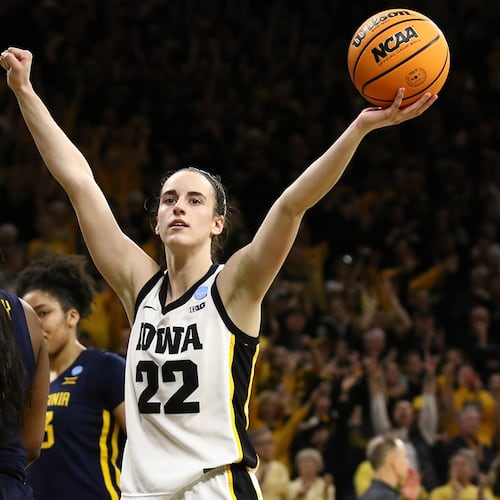It’s scary, yes. The Atlanta Braves’ starting pitchers for their opening series in Philadelphia this week include Julio Teheran, who made the playoff roster only as a long reliever, and then two rookies. Max Fried is penciled in as the No. 5 starter. Mike Foltynewicz, Kevin Gausman and Mike Soroka aren’t yet healthy. Touki Toussaint has been sent to the minors. The team that didn’t sign a starter over the winter is running low on starters, and it’s not yet April. The Braves are doomed!
Well, aren’t they?
We’ve knew the day would come when the Braves, who spent three manic years stockpiling young pitching, would deploy those young pitchers, one after another, in big-league games. Some have arrived – Sean Newcomb in June 2017, Soroka last May, Toussaint last August. Matt Wisler and Aaron Blair were found wanting and are Braves no more. Luiz Gohara made some promising starts but got hurt and hasn’t shown much promise since. Kolby Allard came up and impressed no one.
This is not failure. This was part of the plan. The Braves of Coppolella/Hart were under no illusion that every young arm would be a Koufax or a Clemens. John Hart’s phrase: “It takes 10 to get three.” (Sometimes he’d narrow it to, “It takes 10 to get one.”) This was always meant as a numbers game, which is why John Coppolella dealt in volume. The more pitchers you have, the better your odds.
Another baseball saying: There’s no such thing as a pitching prospect. The meaning therein: By the nature of their business, pitchers are either proven or unproven, and there’s no real proof until a guy is working in a stadium that has three decks of seats. At some point, an organization must hold its breath and see what the kid with the big arm can do against big-league hitters.
Foltynewicz, acquired from Houston in the Evan Gattis trade, took a while to settle but became an All-Star at 26. Newcomb, imported from the Angels in the Andrelton Simmons deal, has held a place in the rotation for nearly two years. Soroka looked to be the real deal until his shoulder started barking, which is another reason there’s no such thing as a surplus of arms. (Bobby Cox: “Whenever you think you have enough pitching, you’d better get some more.”)
Scheduled to start Game 2 in Philly is Bryse Wilson, considered a lesser light in this system until very recently. He was the fourth high school pitcher drafted by the Braves in June 2016, behind first-rounders Ian Anderson and Joey Wentz and second-rounder Kyle Muller. Wilson began last season in High-A. He finished it in the majors. His spring training ERA is 3.24. He has struck out 13 in 13-2/3 innings.
You wouldn’t have guessed Wilson would be starting big-league games before Anderson/Wentz/Muller, but that’s another thing about pitchers: You can’t ever know. Dallas Keuchel, to drop a name mentioned often in Braves-related conversations, was a seventh-round pick who won a Cy Young.
The Game 3 starter is Kyle Wright, who was absolutely deemed a big get. The Braves hooked him with the fifth overall pick in 2017. He wasn’t a high-school arm – he spent three years at Vanderbilt – but the former front office rated him so highly it waived its reservations about college pitchers. He has been fast-tracked from the moment he signed. He has a high spring ERA (7.11); he has also struck out 18 in 12-2/3 innings.
Fried, the tentative fifth starter, arrived from San Diego in the December 2014 trade for Justin Upton. The Braves wanted him even though they knew that, having just had Tommy John surgery, he’d miss the 2015 season. He has made nine big-league starts, only once yielding more than three earned runs. He has a big curveball and, by the end of last season, was touching 95 mph on his four-seamer. The Braves have debated whether Fried’s future is as a bottom-of-the-rotation starter or a middle reliever, but he’d be taking a regular turn on more than a few clubs.
No, this isn’t what the Braves had in mind when they headed south to Lake Buena Vista, but this is what they’ll have coming north. In the grand scheme, it might actually be a good thing. If these young pitchers can hold their own until Foltynewicz and Gausman are ready – Soroka figures to take a while longer – the cries to sign Keuchel will abate.
Of all teams, the Braves should never run low on arms. (Seasoned arms, maybe.) They remade themselves around pitching, which some teams are reluctant to do because hitters project better than pitchers. But this was the plan, and the plan was executed, and the fruits of those organizational labors remain.
Even with Ronald Acuna and Ozzie Albies in the majors, MLB Pipeline stills ranks the Braves' farm system second-best to San Diego's. And the Braves, we say again, are no longer a 90-loss team looking to get good. They're the reigning National League East champs. They've arrived as a big-league club, and still 17 of their top 22 prospects, per MLB Pipeline, are pitchers.
Some of those won’t pan out. Some will. We’re about to see two of them try against Bryce Harper and the beefed-up Phillies. Maybe it’ll go badly. Maybe it won’t. But we’ll leave you with hoariest of baseball truisms: Good pitching stops good hitting. And there’s no age limit on good pitching.
About the Author
The Latest
Featured


